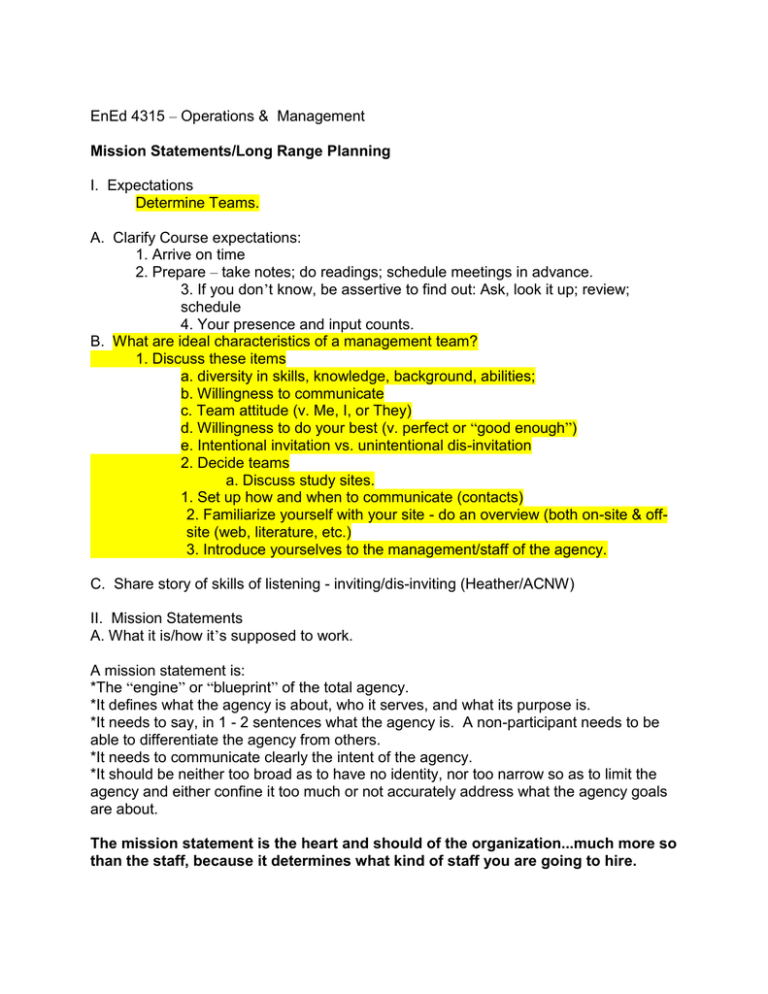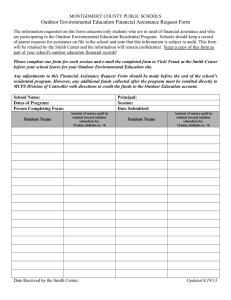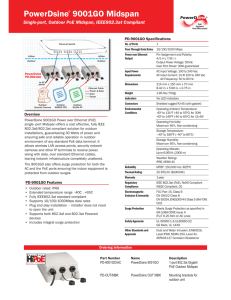Mission Notes
advertisement

EnEd 4315 – Operations & Management
Mission Statements/Long Range Planning
I. Expectations
Determine Teams.
A. Clarify Course expectations:
1. Arrive on time
2. Prepare – take notes; do readings; schedule meetings in advance.
3. If you don’t know, be assertive to find out: Ask, look it up; review;
schedule
4. Your presence and input counts.
B. What are ideal characteristics of a management team?
1. Discuss these items
a. diversity in skills, knowledge, background, abilities;
b. Willingness to communicate
c. Team attitude (v. Me, I, or They)
d. Willingness to do your best (v. perfect or “good enough”)
e. Intentional invitation vs. unintentional dis-invitation
2. Decide teams
a. Discuss study sites.
1. Set up how and when to communicate (contacts)
2. Familiarize yourself with your site - do an overview (both on-site & offsite (web, literature, etc.)
3. Introduce yourselves to the management/staff of the agency.
C. Share story of skills of listening - inviting/dis-inviting (Heather/ACNW)
II. Mission Statements
A. What it is/how it’s supposed to work.
A mission statement is:
*The “engine” or “blueprint” of the total agency.
*It defines what the agency is about, who it serves, and what its purpose is.
*It needs to say, in 1 - 2 sentences what the agency is. A non-participant needs to be
able to differentiate the agency from others.
*It needs to communicate clearly the intent of the agency.
*It should be neither too broad as to have no identity, nor too narrow so as to limit the
agency and either confine it too much or not accurately address what the agency goals
are about.
The mission statement is the heart and should of the organization...much more so
than the staff, because it determines what kind of staff you are going to hire.
Do not underestimate the importance of your mission statement!!
*Be sure that the mission statement is congruent with the bigger agency representation
if you have a mission within a larger organization (Parks & Rec w/in City Charter;
Outdoor Program w/in UMD w/in U of M)
B. Goals and Objectives
For the mission statement, these need to determine how the mission will be carried out in broad strokes. They are not as specific as goals/objectives in a specific lesson plan.
*They must serve as a more specific and unambiguous direction for the agency.
*Definitions:
The Vision is the ideal “place” the agency wants to strive to be. For example, “we want
to have a state-of- the-art outdoor educational agency that provides training for
instructors of outdoor educational programs. Our aim is to provide the finest in
environmentally responsible facilities that model environmental literacy and maximize
learning, blend traditional with the most advanced technological equipment, and hire the
leading faculty in the world to best reach our students. Finally, our goal is to be leaders
in our field by conducting research that guides the best learning practices.”
“A mission statement is an overarching definition of why the agency exists and what it
strives to accomplish. It is based on the enabling decisions (legislation, parent
organization {i.e., U of M}, etc, if applicable) as passed by the
corporate/legislative/Board of Directors or founders).”
Purpose statements clarify the reasons the agency was established and is managed
as a unit of its parent agency. These reasons are specific to the
agency/department/program and are based on the agency’s enabling
legislation/decision, history, and other formal designations.
Significance statements summarize the essence of the agency’s importance. By
recognizing the agency’s significance, the manager can ensure that future decisions
protect and enhance the very things that make the agency distinctive.
In general, management planning, purpose, and significance statements are used to:
*Provide the foundation and help set parameters for how the agency should be
managed and used, and which provide the standard and rationale against which
proposed decisions and actions can be measured.
*Help to set priorities that ensure preservation and conservation of resources and
values necessary to accomplish the agency’s purposes.
“Help users and surrounding community understand the rationale behind management
decisions.”
Objectives are the specific, measurable, means of achieving the mission and purpose.
For this aspect of management, the objectives tend to be broader based.
See Outdoor Program objectives.
Taken from: Przybylski, K. & West, B. (1998). Voyageurs National Park
Newsletter. Vol. 1. August. pp. 2-3.
III. Building a board
A. Advisory Board
B. Working Board
C. Composition (see notes)
IV. Hierarchical Chart
A. Indicates the flow & style of management (top-down or vice versa
B. Indicates the number and types (skills and qualifications) of staff.
V. Long Range Planning
These are the specific ways that you are projecting what your agency will be like in the
future. Typically, for a human service program (vs. A corporation like UM), a 1, 3, & 5
year plan is designed.
I suggest you include personal goals as well. Why? Because personal goals of staff
are directly related to the outcome (both successes and limitations) of the organization.
*It is essential to look to the future to see where you want to go. You also need to be
able to look back and see where you’ve come. Likewise, don’t forget the here and now.











